Faye Driscoll at Danspace St. Marks and Netta Yerushalmy at the Harkness Dance Center bring spectators and performer closer together.
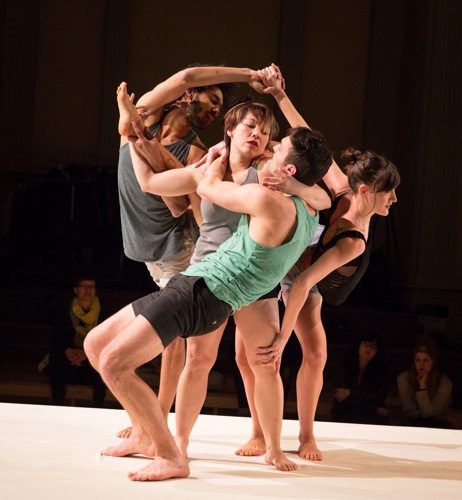
L to R: Brandon Washington, Nikki Zialcita, Sean Donovan, and Giulia Carotenuto (hidden: Alicia Ohs) at the dress rehearsal of Faye Driscoll’s Thank You For Coming: Attendance. Photo: Yi-Chun Wu
The so-called fourth wall that separates performers from the spectators who’ve come to watch them is not always an obvious barrier like that created by a proscenium stage. Often it’s a virtual boundary that involves very little distance between the two zones. I’ve been at events in lofts where the audience is seated so close to the performing area that a first-row spectator could reach out and snag a dancer. But no one does.
Ever since the 1960s, choreographers have occasionally become interested in breaching that barrier—perhaps as a stand against elitism, perhaps for the more practical reason of getting audiences to feel warm and comfortable about people who can do things with their bodies that would stymy most non-dancers. “Community” is a key word in such an endeavor, whether the aim is to alter the aesthetic experience to see how it affects art-making and/or to build an audience for dance.
Faye Driscoll has a bundle of strategies for involving the audience for her new Thank You For Coming: Attendance. Some of these devices are more potent than others and deepen the work; others make more token gestures of camaraderie. Driscoll has reconfigured St, Mark’s Church by setting wooden benches on all four sides of the open nave. In the center of the area that they confine is a low, rectangular platform 12 x 15 feet. For the first section of the piece, some spectators sit on the floor, pressed against the platform, their eyes level with the performers’ feet. (That we all have to hang up our coats, take off our shoes, and ditch our bags makes us feel primed to be more mobile than is usual.)
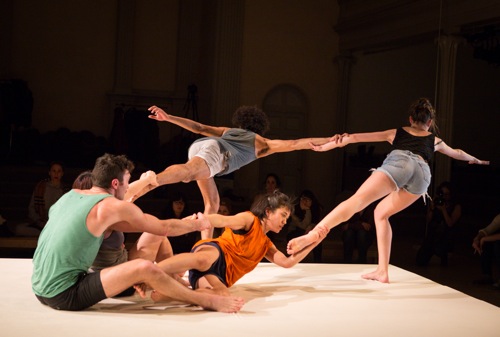
L to R: Sean Donovan, Nikki Zialcita (hidden), Brandon Washington, Alicia Ohs, and Giulia Carotenuto in Thank You For Coming: Attendance. Photo: Yi-Chun Wu
This opening sequence is a wonder. Five dancers assemble on the platform: Giulia Carotenuto, Sean Donovan, Alicia Ohs, Brandon Washington, and Nikki Zialcita. Constantly finding new ways to hang on to one another, they test the boundaries of the space and how much can be accomplished within it. Their group positions would call to mind the plastiques of early “interpretive” dance, except that they’re raunchier than that (someone’s foot is likely to end up pressing against someone else’s cheek). But the formations are also beautiful—uncanny architecture made up of cantilevers and intimate linkages. The performers build these through slow chain reactions, sustain them for a few seconds, and then transform them or collapse for a brief respite. You may think of fairytale bridges; struggling mountain climbers; the dying bodies in Gericault’s painting, “The Raft of the Medusa;” or a Rube Goldberg contraption that has lost its purpose. The five can make a tableau revolve without breaking their positions (how long can Carotenuto rotate with one leg held high and the others clinging to her?).
Their actions gradually take them toward the edges of the platform to reach out from it and touch or cleave the rows of watchers sitting on the floor. Eventually, they roll in a chain toward the south end of the space, pushing the seated people ahead of them. Then they roll back onto the platform, tear off its white plastic covering, and roll themselves up in it as they head north, herding more audience members. Uncovered, the platform turns out to be made of benches, and Driscoll, who’s been beneath them, amplifying it with a microphone, starts shifting them. Unaided, she sets all 24 of them around around the square, rousing spectators to get up and re-seat themselves.
One strategy is to have the dancers to hand out stuff—little artificial bouquets to some of us, gold foil shower caps to others, various and other props that they may later retrieve. I get Driscoll’s reasoning (when the dancers take back and don some of the silly hats, they unite with us), but the only really pungent use of the props comes when some spectators clumped together suddenly stand up and wave the little black pieces of cloth they’ve been given when we weren’t paying attention.
Selected spectators are also gently drafted (mostly by Driscoll playing hostess) to join the dancers in skipping in a circle, plus into and away from its center. I flash back to similar scenes in other works over the years; these all look alike: the experienced dancers being encouraging and roughing up their expertise, the recruits looking embarrassed but game, or delighted to be part of the gang.
A better fourth wall breakthrough occurs at the end of Thank You For Coming: Attendance, when audience members are recruited to hold the ends of the pieces of fabric that eventually will be lifted via ropes to form a raggedy maypole (made magical by Amanda K. Ringer’s lighting) or to anchor the suddenly appearing, endlessly long gray tights that the dancers crawl themselves out of. Now they’re workers too.
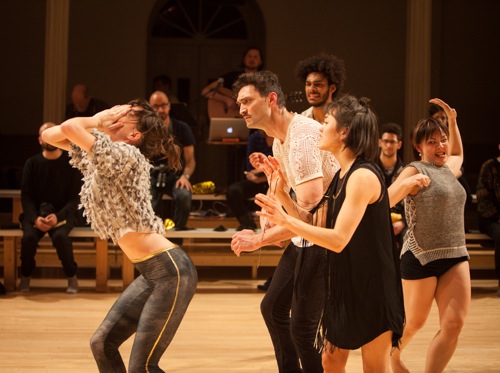
L to R: Giulia Carotenuto, Sean Donovan, Brandon Washington, Nikki Zialcita, and Alicia Ohs
in the dress rehearsal of Faye Driscoll’s premiere. Photo: Yi-Chun Wu
During another subtle integration of performers and audience, the dancers begin a long sequence in which they deconstruct a series of encounters and responses by performing every step, gesture, and facial expression as a series of tiny jerks or vibrations. They look like wind-up toys enacting separate, disjoined melodramas, although it takes them forever to move a few feet. Sometimes they seem to be saying, “Hi, glad to see you; come right in.” At other times, it’s get your paws off her!” Throughout this sequence, Michael Kiley is playing guitar chords and reciting first names. Sometimes he says a name three times, and the dancers echo him. Suddenly I get it: these are our names, garnered when we picked up our tickets.
All sorts of erotic and abusive vignettes form and dissolve—some in bizarre ways: Washington sucks his finger and sticks it in Carotenuto’s ear; she reacts with predictable disgust. He hits the air near Zialcita over and over; she whips her head to one side—stuck-in-a-groove abuse.
And the dancers have to repeat the entire sequence, eventually building up speed, until every name has been said. We’re their accompaniment, but also, in some strange way, we control them.
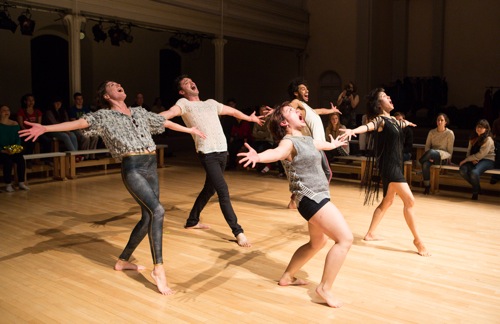
L to R: Giulia Carotenuto, Sean Donovan, Nikki Ziacita (front), Brandon Washington, and Alicia Ohs. Photo: Yi-Chun Wu
The performers—who also show us what they can do in the way of boisterous unison dancing and chanting, are highly individual and terrific—and what with changing their outfits (construction and alteration by Sarah Thea Swafford), they get little rest.
Maybe because we’re in our stocking feet and can walk on St. Marks’ beautiful wood floor, we audience members don’t all grab our stuff and run. People hang around in the performing-spectating space, talking to one another and to the dancers. So maybe, on Driscoll’s terms, the fourth wall has fallen or, at least, its sturdiness has been thoroughly tested.
The mission of the Harkness Dance Festival’s Stripped/Dressed series is to demystify dance as an enigmatic possibly hard to understand art by revealing the processes and sources that produce a dance. The five events curated by Doug Varone begin with the choreographer speaking to the spectators who are seated close to the action in the 92nd Street YM-YWHA’s Buttenweiser Hall, a jewel of a room, with its painted art deco ceiling, that is no bigger than a medium-sized dance studio. Passages from a particular dance may be demonstrated and talked about. Then the dancers return in costume and perform either a recent work, an early work, or an in-process one.
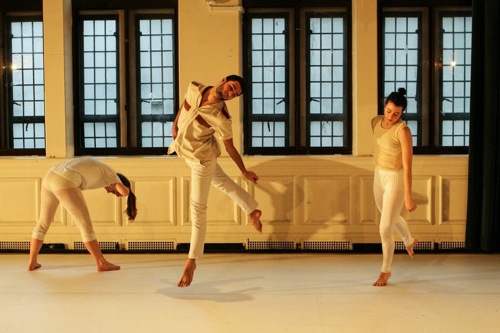
L to R: Amanda Kmett’Pendry, Marc Crousillac, and Sarah Lifson in Netta Yerushalmy’s untitled work-in-progress. Photo: Julie Lemberger
On the third weekend of Stripped/Dressed, with two to go (Kyle Abraham/Abraham in Motion, then David Dorfman Dance), Netta Yerushalmy has chosen to present an untitled work-in progress that will premiere in November. Standing beside a monitor with slides to show, she starts out as a nervous talker (I will myself not to count the “um”s and “uh’s that punctuate her talk), but when she gets deep into what intrigues—no, enthralls—her, she becomes eloquent. She’s interested in the visual arts, mostly particularly the works of Pablo Picasso and Georges Braque labeled Synthetic Cubism and talks about the body as architecture as well as persona.
For this new piece, she isn’t casting the contemporaries she usually works with; the three dancers she has brought to the Y are younger and less experienced (students of her, I think she said), but they perform the movement she has devised with skill and a kind of directness that’s very engaging. Amanda Kmett’Pendry demonstrates a phrase of movement—a long, rich one. One of the things that I find so absorbing about Yerushalmy’s movement style is how three-dimensional it is. We seldom see the dancer’s body from the same angle for long; Kmett’Pendry may lift a leg behind her and then, before putting it down, turn her body 180 degrees to face it. The movement is bold—canting off balance, then recovering to loop off in another direction, maybe to leave the ground. Yerushalmy’s choreography is unusual, in part because of the satisfying way she employs contrasting dynamics—small gestures contrast with big, whole-body moves; jerky passages with smooth ones; slowness with speed; repetition with a high rate of change; roughness with elegance.
Her talk gets really interesting when she starts talking about Gertrude Stein’s word play, the ways in which Stein’s repeating chunks of language eventually reveal a story. She reads a few lines and says she wanted “to make a dance that looks the way this reads.” The Stein inspiration tallies with the Cubist practice of snipping bits of reality from their usual space-time relationship. These influences, of course, aren’t visible in the finished work; they just ignited a process. For instance, Yerushalmy explains that she wrote words from a Stein text as a vertical list and randomly ascribed a movement to each to create a disjunctive structure.
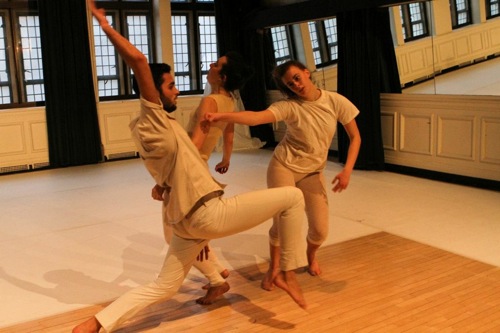
L to R: Mar Crousillat, Sarah Lifson, and Amanda Kmett’Pendry in Yerushalmy’s work-in-progress. Photo: Julie Lemberger
Marc Crousillat demonstrates the result of what must have been a laborious process the choreographer calls “amalgams.” He has taken the phrase we just saw and woven into it a phrase of his own choosing (maybe even by another choreographer, I think)—that is, inserted a bit of it here, a bit of it there. “Chunked up” is how Yerushalmy refers to the result. Sara Lifson inserts moves from a third phrase into the previous two. I’m on the edge of my seat; this ingenious process ingenious may not be catnip to every viewer, but it is to me.
After a break, the three return, wearing unpretentious white outfits by Crousillat and Magdalena Jarkowiec. Bill Schaffner starts doing equally unpretentious but very effective things with lights, and after a few moments, composer Judith Berkson, sitting in a front-row seat, suddenly sings a high, piercing note. After a few seconds, she sings a softer one. Her music too comes in chunks at first—islands in silence. Sometimes, she emphasizes what’s occurring. For instance, Lifson stands and repeatedly turns her head to one side, squinting each time she does so; Berkson gives her a tone each time. But more often, the spare score is less closely tied to the dancing. Later the composer plays chords on what looked like a toy version of a melodica. (About the squint. Yerushalmy has remarked that she’s experimenting. Can a facial expression be as abstract as a movement, or do we always read it as an emotional reaction?).
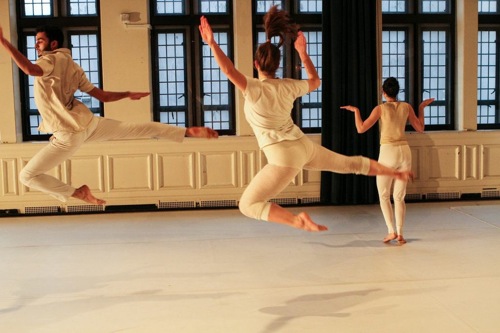
L to R: Amanda Kmett’Pendry, Marc Crousillat, and Sarah Lifson in Netta Yerushalmy’s work-in-progress. Photo: Julie Lemberger
This choreography keeps your eyes darting here and there to capture events glimpsed out of the corner of your eye and echoed half a stage away. A bustle of dancing dissolves into unison. A sequence in which three people do different things elides into, say, a passage in which two move identically, and one goes off on a tangent. The contrasts I mentioned abound—now made more complex by the formations of the group. The dancers may cluster and stand still for a surprisingly long time, then slowly start slanting their arms in various directions. They may launch themselves into the air in a way that makes me want to use the verb “gambol.” They run out one of the hall’s doors and in the other. They rush to the windows and perch on the sills, while Schaffner turns out all the spotlights and turns on the chandeliers, and Berkson sings a melody and walks up to confront them
They also tease us about whether an ending is imminent—frolicking near one of the doors, exiting, and returning to run around a little more, then leaving, then coming back. Finally the singer turns, and they cluster around her in a pool of light. Which then goes out.
Some of the spectators for this Stripped/Dressed event will doubtless see the finished dance in November. I don’t know whether they will “understand” it better because of having had a glimpse of the process behind it, but that, to me, isn’t really the point. What they will have, for sure, is a clearer sense of how creative some dancers have to be and of the various ways in which choreographers sense the world and translate experience into art.

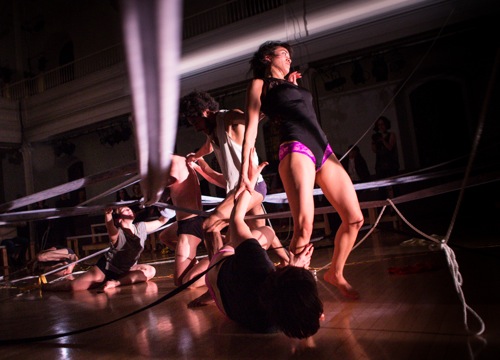
I saw the work in an earlier showing, and agree completely. Faye and company will be returning to The Yard artist residency and performance center (Chilmark, MA) in 2015 under the working rubrique, “New Women of Old Vaudeville.” The series looks at women working with humor in dance and performance, and will also include Chicago’s Lucky Plush and Philadelphia’s Charlotte Ford, among others.